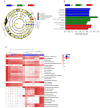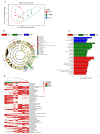Gut Microbiome Profiles and Associated Metabolic Pathways in HIV-Infected Treatment-Naïve Patients
- PMID: 33668457
- PMCID: PMC7917727
- DOI: 10.3390/cells10020385
Gut Microbiome Profiles and Associated Metabolic Pathways in HIV-Infected Treatment-Naïve Patients
Abstract
The normal composition of the intestinal microbiota is a key factor for maintaining healthy homeostasis, and accordingly, dysbiosis is well known to be present in HIV-1 patients. This article investigates the gut microbiota profile of antiretroviral therapy-naive HIV-1 patients and healthy donors living in Latin America in a cohort of 13 HIV positive patients (six elite controllers, EC, and seven non-controllers, NC) and nine healthy donors (HD). Microbiota compositions in stool samples were determined by sequencing the V3-V4 region of the bacterial 16S rRNA, and functional prediction was inferred using PICRUSt. Several taxa were enriched in EC compared to NC or HD groups, including Acidaminococcus, Clostridium methylpentosum, Barnesiella, Eubacterium coprostanoligenes, and Lachnospiraceae UCG-004. In addition, our data indicate that the route of infection is an important factor associated with changes in gut microbiome composition, and we extend these results by identifying several metabolic pathways associated with each route of infection. Importantly, we observed several bacterial taxa that might be associated with different viral subtypes, such as Succinivibrio, which were more abundant in patients infected by HIV subtype B, and Streptococcus enrichment in patients infected by subtype C. In conclusion, our data brings a significant contribution to the understanding of dysbiosis-associated changes in HIV infection and describes, for the first time, differences in microbiota composition according to HIV subtypes. These results warrant further confirmation in a larger cohort of patients.
Keywords: human immunodeficiency virus; metabolism; microbiome; sexual orientation; virus subtypes.
Conflict of interest statement
The authors report no conflict of interest.
Figures




Similar articles
-
Richer gut microbiota with distinct metabolic profile in HIV infected Elite Controllers.Sci Rep. 2017 Jul 24;7(1):6269. doi: 10.1038/s41598-017-06675-1. Sci Rep. 2017. PMID: 28740260 Free PMC article.
-
Alterations in the gut microbiota of patients with acquired immune deficiency syndrome.J Cell Mol Med. 2018 Apr;22(4):2263-2271. doi: 10.1111/jcmm.13508. Epub 2018 Feb 7. J Cell Mol Med. 2018. PMID: 29411528 Free PMC article.
-
Unique Gut Microbiome in HIV Patients on Antiretroviral Therapy (ART) Suggests Association with Chronic Inflammation.Microbiol Spectr. 2021 Sep 3;9(1):e0070821. doi: 10.1128/Spectrum.00708-21. Epub 2021 Aug 11. Microbiol Spectr. 2021. PMID: 34378948 Free PMC article.
-
HIV, Sexual Orientation, and Gut Microbiome Interactions.Dig Dis Sci. 2020 Mar;65(3):800-817. doi: 10.1007/s10620-020-06110-y. Dig Dis Sci. 2020. PMID: 32030625 Free PMC article. Review.
-
Complexities of Gut Microbiome Dysbiosis in the Context of HIV Infection and Antiretroviral Therapy.Clin Pharmacol Ther. 2016 Jun;99(6):600-11. doi: 10.1002/cpt.363. Epub 2016 Apr 16. Clin Pharmacol Ther. 2016. PMID: 26940481 Free PMC article. Review.
Cited by
-
Alterations in the gut microbiota of AIDS patients with pneumocystis pneumonia and correlations with the lung microbiota.Front Cell Infect Microbiol. 2022 Oct 21;12:1033427. doi: 10.3389/fcimb.2022.1033427. eCollection 2022. Front Cell Infect Microbiol. 2022. PMID: 36339339 Free PMC article.
-
Major depletion of insulin sensitivity-associated taxa in the gut microbiome of persons living with HIV controlled by antiretroviral drugs.BMC Med Genomics. 2024 Aug 13;17(1):209. doi: 10.1186/s12920-024-01978-5. BMC Med Genomics. 2024. PMID: 39138568 Free PMC article.
-
The contemporary immunoassays for HIV diagnosis: a concise overview.Asian Biomed (Res Rev News). 2023 Aug 7;17(1):3-12. doi: 10.2478/abm-2023-0038. eCollection 2023 Feb. Asian Biomed (Res Rev News). 2023. PMID: 37551202 Free PMC article. Review.
-
Therapeutically targeting the consequences of HIV-1-associated gastrointestinal dysbiosis: Implications for neurocognitive and affective alterations.Pharmacol Biochem Behav. 2023 Aug;229:173592. doi: 10.1016/j.pbb.2023.173592. Epub 2023 Jun 29. Pharmacol Biochem Behav. 2023. PMID: 37390973 Free PMC article.
-
SIV/SARS-CoV-2 coinfection in rhesus macaques impacts viral shedding, host immunity, the microbiome, and viral evolution.Front Immunol. 2025 May 20;16:1587688. doi: 10.3389/fimmu.2025.1587688. eCollection 2025. Front Immunol. 2025. PMID: 40463375 Free PMC article.
References
-
- UNAIDS . UNAIDS Data 2020. UNAIDS; Geneva, Switzerland: 2020. [(accessed on 26 September 2020)]. Available online: https://www.unaids.org/sites/default/files/media_asset/2020_aids-data-bo....
-
- Gori A., Tincati C., Rizzardini G., Torti C., Quirino T., Haarman M., Amor K.B., Van Schaik J., Vriesema A., Knol J., et al. Early impairment of gut function and gut flora supporting a role for alteration of gastrointestinal mucosa in human immunodeficiency virus pathogenesis. J. Clin. Microbiol. 2008;46:757–758. doi: 10.1128/JCM.01729-07. - DOI - PMC - PubMed
Publication types
MeSH terms
LinkOut - more resources
Full Text Sources
Other Literature Sources
Medical

